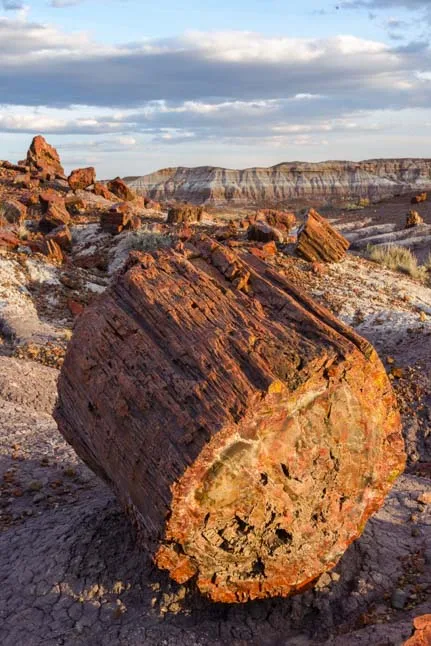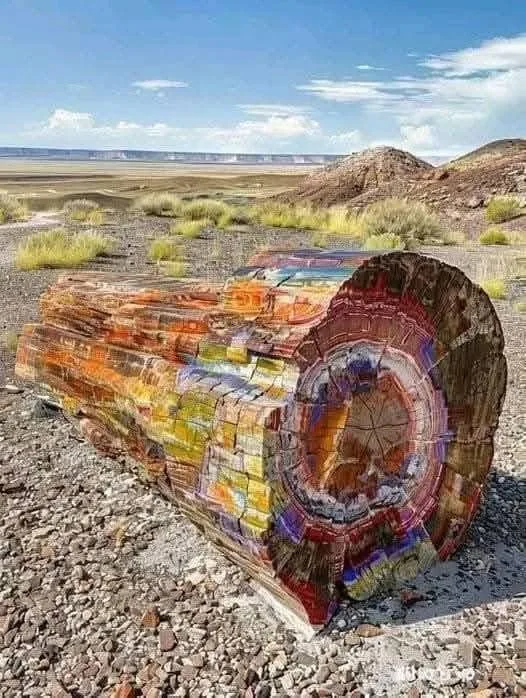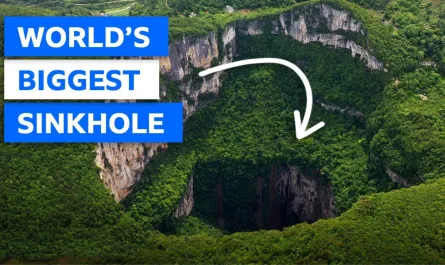Tucked away in the vibrant deserts of northeastern Arizona, Petrified Forest National Park is a geological time capsule, home to one of the world’s most stunning collections of petrified tree stumps.
These fossilized remnants of ancient trees, which thrived 225 million years ago during the Late Triassic period, offer a mesmerizing glimpse into a prehistoric world. Let’s explore the wonders of these fossilized giants, how they came to be, and why this national park is a must-visit destination.

A Forest Frozen in Time
Millions of years ago, the area now known as Petrified Forest National Park was a lush, tropical floodplain teeming with towering coniferous trees, some reaching heights of over 100 feet. When these giants fell—likely due to natural events like floods or volcanic activity—they were buried under layers of sediment. Over time, silica-rich groundwater seeped into the buried logs, replacing organic material with minerals like quartz, transforming the wood into vibrant, fossilized stone.

The result? A dazzling array of petrified tree stumps scattered across the landscape, their colors ranging from deep reds and oranges to purples and blues, thanks to trace minerals like iron and manganese.
These petrified logs, some still strikingly tree-like with visible bark and growth rings, are a testament to the slow artistry of nature. The park’s most famous areas, like the Crystal Forest and Rainbow Forest, showcase these fossils in abundance, creating an otherworldly scene that feels like stepping onto another planet.
Why Visit Petrified Forest National Park?

Geological Marvel: The petrified stumps are among the largest and most colorful fossilized trees in the world, offering a rare window into Earth’s distant past.
Diverse Attractions: Beyond the petrified wood, the park features vibrant badlands, ancient petroglyphs, and fossils of early dinosaurs and other prehistoric creatures.
Hiking and Exploration: Trails like the Crystal Forest Trail (1-mile loop) and Giant Logs Trail (0.4-mile loop) let you walk among the fossils, while the Blue Mesa Trail offers stunning views of the park’s colorful geology.
Cultural Significance: The park includes archaeological sites like Puerco Pueblo, with petroglyphs left by Ancestral Puebloans, adding a human dimension to the prehistoric narrative.
Photography Heaven: The vivid colors of the petrified wood against the desert backdrop make for unforgettable photos, especially at sunrise or sunset.
How to Get There

Location: The park is located off Interstate 40, about 25 miles east of Holbrook, Arizona, roughly a 3.5-hour drive from Phoenix or 2.5 hours from Flagstaff.
Access: Enter via the north entrance (Exit 311 off I-40) or the south entrance near Holbrook. The 28-mile scenic drive through the park connects both entrances.
Cost: Entry is $25 per vehicle (7-day pass) or free with an America the Beautiful Pass.
Hours: Open daily from 8 AM to 5 PM, with extended hours in summer (check the National Park Service website for updates).
Accessibility: Many trails, like the Giant Logs Trail, are paved and wheelchair-accessible. The Rainbow Forest Museum and Visitor Center also offer accessible facilities.
What to Do
Walk Among Fossils: Explore the Crystal Forest or Giant Logs trails to see petrified stumps up close. The Long Logs Trail features one of the park’s largest concentrations of fossilized trees.
Visit Museums: The Rainbow Forest Museum and Painted Desert Visitor Center offer exhibits on the park’s fossils, geology, and history, including skeletons of prehistoric creatures like the crocodile-like Phytosaur.
Hike the Badlands: The Blue Mesa Trail (1 mile) winds through colorful badlands, while the Painted Desert Rim Trail offers panoramic views of the park’s iconic striped hills.
Discover History: Check out Puerco Pueblo for ancient petroglyphs or the Agate House, a reconstructed pueblo made of petrified wood.
Stargazing: The park’s remote location makes it a fantastic spot for night sky viewing, with occasional ranger-led stargazing events.
Best Time to Visit
Spring (March–May) and fall (September–November) offer mild temperatures and fewer crowds, ideal for hiking and photography. Summer can be hot (highs above 90°F), so plan for early morning visits. Winter is quieter but can bring cold weather and occasional snow. Always bring water, sunscreen, and sturdy shoes, as the desert environment is unforgiving.
Tips for Your Trip
Protect the Park: Removing petrified wood is illegal and carries heavy fines. Leave the fossils for future generations to enjoy.
Stay on Trails: Wandering off-trail can damage fragile fossils and ecosystems.
Combine Your Visit: Pair the park with nearby attractions like the Grand Canyon (3.5 hours away) or Meteor Crater (1 hour away) for a grand Arizona adventure.
Guided Tours: Consider a ranger-led tour or a photography tour for deeper insights into the park’s geology and history.
Plan for a Day: A full day is enough to explore the main trails, visitor centers, and scenic drive, though campers can stay longer at nearby sites (no camping is available within the park).
A Journey to the Past

Petrified Forest National Park is more than a collection of fossilized trees—it’s a portal to a world 225 million years ago, where ancient forests thrived and early dinosaurs roamed. The vibrant petrified stumps, set against the stark beauty of the Painted Desert, create a landscape that’s both humbling and awe-inspiring. Whether you’re a geology enthusiast, a history buff, or simply a curious traveler, this park offers a unique adventure that connects you to Earth’s ancient story.
Have you visited Petrified Forest National Park, or is it on your travel list? Share your thoughts or questions below, and let’s keep exploring the wonders of our planet!

